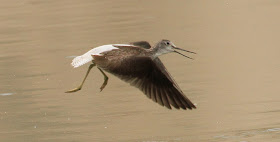I took the following photo recently of 3 different Sandpipers together. Can you name them?
The Sandpipers are at Alice Springs presumably on their way further south for summer, or here until nearly winter. One of our more longer term residents is the Sharp-tailed Sandpiper:
The Common Greenshank is one I re-encountered a few weeks ago at Docker River. Definitive by its high "peep" as it flies, I have included some shots below which show its markings as well.
The Common Sandpiper is one I find fairly easy to identify due to its plain brown colouring and white eyering as per below
I love the iridescent colours of the feathers in the wings of Pacific Black Ducks and how they change depending on the light. You can see the purple on the left hand wing in this photo.
Red-necked Avocets seem to be a very accommodating fly-by bird as can be see by the photo below
Sanderlings, one a bit more mature than the other in the foreground, or perhaps a male and a female, not sure
And finally, a rather pinky/red coloured Yellow-billed Spoonbill. Obviously being playing around in the Central Australian dirt!
The Sandpipers are at Alice Springs presumably on their way further south for summer, or here until nearly winter. One of our more longer term residents is the Sharp-tailed Sandpiper:
(I think this one was just testing how cold or warm the water was, just a toe in! :0) )
The Common Greenshank is one I re-encountered a few weeks ago at Docker River. Definitive by its high "peep" as it flies, I have included some shots below which show its markings as well.
The Common Sandpiper is one I find fairly easy to identify due to its plain brown colouring and white eyering as per below
I love the iridescent colours of the feathers in the wings of Pacific Black Ducks and how they change depending on the light. You can see the purple on the left hand wing in this photo.
Red-necked Avocets seem to be a very accommodating fly-by bird as can be see by the photo below
Sanderlings, one a bit more mature than the other in the foreground, or perhaps a male and a female, not sure
And finally, a rather pinky/red coloured Yellow-billed Spoonbill. Obviously being playing around in the Central Australian dirt!

















Great shots there Richard. Love the Greenshank with reflection. Your three Sandpipers look like Common, Wood and Sharp-tailed to me.
ReplyDeleteThanks John, and the three IDs were my thoughts too. The Sharp-tailed was the unusual one on the day as there were so many others around but this one was hanging about with the other two.
DeleteHey Richard, do you normally have Sanderlings in Central Aus? I thought they were more of a coastal wader?
ReplyDeleteYou've really picked up the "sharp tails" in the sharpies too.
Hi John, no Sanderlings are unusual. We have had a bumper year for waders recently. Oriental Plover, Painted Snipe as well as Sanderling. No real explanation, maybe so much of inland Australia is so dry.
Delete